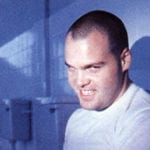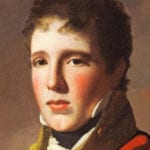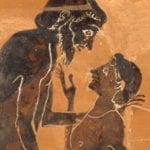 Weird Stuff
Weird Stuff  Weird Stuff
Weird Stuff  Mysteries
Mysteries 10 Tragic Disappearances and Deaths in Joshua Tree National Park
 History
History 10 Ways Childhood Really Sucked in the Old West
 Music
Music 10 Name Origins of Famous Bands from the 1990s
 Religion
Religion 10 Biggest Turnarounds by the Catholic Church
 Weird Stuff
Weird Stuff 10 Unbelievable Times Laws Had Unintended Consequences
 Humans
Humans Ten Historic Women Who Deserve Way More Credit Than They Got
 Movies and TV
Movies and TV 10 Films That Spawned Major Lawsuits
 History
History Ten Times Towns Were Wiped Off the Face of the Earth
 Creepy
Creepy 10 of the Most Disturbingly Haunted Public Houses in the UK
 Weird Stuff
Weird Stuff 10 Niche Subcultures That Are More Popular Than You Might Think
 Mysteries
Mysteries 10 Tragic Disappearances and Deaths in Joshua Tree National Park
 History
History 10 Ways Childhood Really Sucked in the Old West
Who's Behind Listverse?

Jamie Frater
Head Editor
Jamie founded Listverse due to an insatiable desire to share fascinating, obscure, and bizarre facts. He has been a guest speaker on numerous national radio and television stations and is a five time published author.
More About Us Music
Music 10 Name Origins of Famous Bands from the 1990s
 Religion
Religion 10 Biggest Turnarounds by the Catholic Church
 Weird Stuff
Weird Stuff 10 Unbelievable Times Laws Had Unintended Consequences
 Humans
Humans Ten Historic Women Who Deserve Way More Credit Than They Got
 Movies and TV
Movies and TV 10 Films That Spawned Major Lawsuits
 History
History Ten Times Towns Were Wiped Off the Face of the Earth
 Creepy
Creepy 10 of the Most Disturbingly Haunted Public Houses in the UK
10 Crazy Things Stanley Kubrick Did To Film ‘The Shining’
Thirty-five years after its release, Stanley Kubrick’s The Shining is still considered one of the best horror films ever made, an example of how movies don’t need to butcher a dozen scantily clad teens to be scary. Listverse has already discussed the crazy conspiracy theories that surround the film, but the things Kubrick did to create his masterpiece were arguably even crazier.
10The Stanley Kubrick/Stephen King War
Initially, King was overjoyed that Kubrick was going to direct an adaptation of his book. The feeling, however, was not mutual. Kubrick called King’s writing “weak” and refused to even look at King’s screenplay, preferring to co-write his own. Kubrick then proceeded to throw out large parts of the book, including what King thought was the premise: Jack Torrance as a regular guy driven insane by alcoholism, solitude, and the paranormal.
King felt that Jack Nicholson was miscast as Jack Torrance, since no one would ever mistake Nicholson for a regular Joe. And since Nicholson’s last performance was his Academy Award–winning role as a mental patient in One Flew Over The Cuckoo’s Nest, King was sure the audience would see his character as mentally unstable from the start. The Jack Torrance character was loosely autobiographical—King suffered from alcoholism while writing the book—and was written to be sympathetic, his descent into madness tragic. But Kubrick’s version of the character is unlikeable from the start and almost seems to deserve what happens to him. Worse, King, who takes pride in his richly developed characters, felt that Kubrick’s script made Wendy Torrance (Shelley Duvall) “one of the most misogynistic characters ever put on film. She’s basically just there to scream and be stupid. And that’s not the woman I wrote about.”
King was so angry at the treatment of his characters he eventually reacquired the rights to his own story so that he could produce a version closer to his book. King’s version eventually became a forgettable 1997 television miniseries, which drew a tepid viewership. One of the conditions for reacquiring the rights was that King had to stop bashing Kubrick’s film. “For a long time I hewed that line,” King told CBS. “And then Kubrick died. So now I figure, what the hell. I’ve gone back to saying mean things about it.”
For his part, Kubrick seems to have made one change as a direct jab at King. In the book, the snowcat is yellow and Torrance’s VW Beetle is red. King actually owned a red VW Beetle while writing the novel and gave his semi-autobiographical character the same car. But in the movie, the VW is yellow and the snowcat is red. Near the end of the movie, Dick Halloran (Scatman Crothers) is driving through a blizzard to the Overlook Hotel when he comes across a red VW Beetle crushed by an 18-wheeler. The accident doesn’t hinder Halloran’s journey and serves no real purpose in the plot. No one who knows how meticulous Kubrick was with the details of his movies could believe this was a coincidence.
9Torturing Shelley Duvall
Kubrick was notorious for mistreating his actors, but nothing compares to the way he treated his lead actress on the set of The Shining. Duvall once characterized working with Kubrick as “excruciating, almost unbearable.” The director harangued her for minor mistakes and forced her to endure a huge number of takes. The scene where she walks backward up the stairs crying and swinging a bat at Jack was shot at least 35 times. Some report it was shot as many as 127 times. It became one of her most powerful scenes, her hands shaking as she holds the bat, her eyes and nose red from actual crying.
Kubrick was constantly rude and dismissive to her on the set, often telling her she was wasting everyone’s time. He was even known to instruct crew members not to show Duvall any compassion. The result was that Duvall looked stressed, tired, and haggard, the very performance Kubrick wanted.
It took four months for Kubrick to film the last hour of the movie, which required Duvall to be hysterical for almost all of her scenes. By the end of filming she was ill and her hair was falling out. She said she cried so much that she had to keep water bottles nearby to keep hydrated. To top it all off, Duvall didn’t even like her character, telling Roger Ebert she much preferred her next role as Olive Oyl in Popeye: “After all of that crying, it was a real treat for me to play Olive Oyl. I loved her. Now don’t laugh: I’ve never before been allowed to play a woman of any strength, of depth. And although Olive Oyl is a cartoon character, I think she does have depth.”
8Shooting The Entire Film In Chronological Order

To save time and money, directors typically go to a location or set and film all the scenes that take place there, no matter where they occur in the script. Once done, the entire crew moves to the next set or location and films the relevant scenes while the previous set is torn down.
But Kubrick loved to change the script as he filmed it, to the point that Jack Nicholson threw away his copy and learned his lines just minutes before the shoot. As a result, Kubrick wanted the story be shot chronologically. That meant hiring every soundstage at Elstree Studios to house all of the sets simultaneously. The sets also had to be kept constantly lit and dressed for shooting.
Inevitably, production of Kubrick’s film ran longer than planned (it occupied Elstree’s soundstages for 11 months) and delayed other productions waiting to use the facilities, including Warren Beatty’s Reds and Steven Spielberg’s Raiders Of The Lost Ark. Two months before Kubrick finished filming, Elstree’s Soundstage 3 burned down, destroying the Colorado Lounge set (the room where Jack types his famous manuscript). Fortunately, it wasn’t needed any more and Spielberg’s team rebuilt the set for the snake pit in his production. The above photo is of Kubrick, laughing amid the wreckage of Soundstage 3.
7The Sets Were Impossible In The Real World
Anyone who has read King’s book knows that the Overlook Hotel is a haunting, malevolent character in the story. Kubrick gave his Overlook interior sets some design anomalies that would subliminally disorient the audience, enhancing the isolated atmosphere and making Overlook seem impossible to escape. Many reviewers shrugged off the anomalies as continuity errors, but Kubrick was too precise and the anomalies too numerous to be unintentional.
The very first scene, in which Jack Torrance is interviewed by the hotel manager for the winter caretaker position, is a good example. After Jack stops at the hotel front desk, he walks by a bank of elevators with people waiting to get on (1:20 in the video above). Behind the group of people is a hallway that stretches both left and right. A few seconds later, Jack walks into the manager’s office, which has a window directly to the back. In the real world, that window would open onto the hallway seen just seconds before, and yet sunlight shines through it and the tops of bushes can clearly be seen.
In the Torrance’s suite, the bathroom and living room are at right angles to each other and both have exterior windows. For this to be possible, the suite would have to sit at the corner of the building. And yet when Danny escapes through the bathroom window, we see that it is not a corner room.
Windows weren’t the only spatial impossibilities on Kubrick’s set. Doors opened behind fireplaces, doors opened to nothing, doors moved from one wall to another, and freezer doors swung one way, then another. The huge ballroom was too big to fit anywhere in the hotel.
Jan Harlan, Kubrick’s brother-in-law and executive producer of The Shining, confirmed that Kubrick’s set designs were intentional. In a 2012 interview with the Guardian, Harlan explained that “the set was very deliberately built to be offbeat and off the track, so that the huge ballroom would never actually fit inside. The audience is deliberately made to not know where they’re going. People say The Shining doesn’t make sense. Well spotted! It’s a ghost movie. It’s not supposed to make sense.” Kubrick himself once said that the hotel’s “labyrinthine layout and huge rooms, I believed, would alone provide an eerie enough atmosphere.”
6Moving And Changing Props
In King’s book, there’s a scene where Danny is lying in bed at the Overlook, contemplating why things in his room have changed. He thinks to himself: “But now things had been misplaced. Things were missing. Worse still, things had been added, things you couldn’t quite see.” Danny’s “Shine” powers did not include telekinesis, the ability to move things with his mind. Only the Overlook Hotel had that power, moving things like a firehose, hedge animals, and the elevator. Although the movie toned down the Overlook’s sentience, it has been speculated that Kubrick still subtly conveyed the hotel’s actions to his audience.
For example, in the movie a table and chair disappear in the Colorado Room. Paper in Jack’s typewriter is pulled out of the roller, then reappears in the roller in the same scene. Chairs in the Gold Room change position in consecutive scenes. A picture shown in the lobby later disappears. Jack’s typewriter even changes color, from white to blue.
It’s quite likely that some of these were simple continuity mistakes. Almost all movies have them and Kubrick, despite his reputation as a perfectionist, had a number of mistakes in his other films. And Kubrick’s penchant for multiple takes of the same scene made it inevitable that such errors would occur. But some of them, like the color of the typewriter, are so blatant that it’s hard to believe they were unintentional on a big budget film with such a seasoned and meticulous director.
5The Constant Do-Overs
We’ve already talked about Duvall’s numerous retakes, but there was one cast member who might have done even more: Scatman Crothers. Already well known for his role as Louie the Garbage Man on NBC’s Chico And The Man, Crothers had worked with Nicholson on One Flew Over The Cuckoo’s Nest. Nicholson asked Kubrick to cast Crothers as Dick Halloran in The Shining, but warned him that the 69-year-old would have problems remembering his lines.
In the scene where Halloran talks to Danny about “Shining,” Crothers repeatedly flubbed his lines. That, combined with the usual difficulties of working with a six-year-old, meant that the scene required an astonishing 140 takes. Another scene where Crothers had 10 lines of dialogue ended up being reshot 100 times, while the tour Halloran gives Wendy and Danny supposedly required 85 takes.
In a 1987 interview, Kubrick explained his reputation for retakes: “It happens when actors are unprepared. You cannot act without knowing dialogue. If actors have to think about the words, they cannot work on the emotion. So you end up doing thirty takes of something. And still you can see the concentration in their eyes. So you just shoot it and shoot it and hope you can get something out in pieces.”
But dialogue wasn’t the only thing the director did over and over. Trial and error were a vital part of his process. An actor who worked with him on another movie said that Kubrick’s favorite phrases were “Do it faster, do it slower, do it again.” Something as simple as a hand gesture or a skewed collar could spark another take.
Indeed, Crothers had to soldier through multiples retakes of scenes with zero dialogue. Kubrick filmed him slamming a door 75 times. His death scene took 40 takes. Near the end of the film, Halloran walks from his snowcat to the Overlook’s front door. Kubrick made Crothers film that 40 times in a row, out in the cold, until Nicholson intervened. Nicholson himself spent three days filming the scene where Jack chops through a bathroom door with an axe, going through 60 doors in the process. That wasn’t totally Kubrick’s decision though—Nicholson had been a volunteer fireman and kept chopping through the doors too quickly.
On the flip side, Kubrick didn’t often rehearse before filming, explaining that “actors who have worked a lot in movies don’t really get a sense of intense excitement into their performances until there is film running through the camera.”
4Mounting A Steadicam On Anything With Wheels
The Steadicam, invented in 1975 by cameraman Garrett Brown, is a harness that gyroscopically isolates a camera from the operator’s movements. Until then, cameras were limited because they had to be mounted on a dolly or boom. With the Steadicam, cameras could go nearly anywhere a person could go. First introduced to the device in 1974, Kubrick was fascinated by how the camera could smoothly shoot almost at ground level. When it came time to film The Shining, he decided to use it for the scene where Danny rides his Big Wheel through the Overlook Hotel. Brown was hired as cinematographer.
Initially, Brown tried to follow Danny’s Big Wheel on foot carrying the 27-kilogram (60 lb) Steadicam, but he told American Cinematographer magazine that the attempt left him “too winded after an entire three-minute take to even describe what sort of last rites I preferred. Also, at those speeds I couldn’t get the lens much lower than about 18 inches from the floor.”
Kubrick’s first solution was for Brown to ride a modified skateboard behind the Big Wheel. When that didn’t work, they tried a wheelbarrow, but that had obvious drawbacks. Finally, they used a wheelchair Kubrick helped modify. Brown would sit in the chair holding the camera so the lens was almost touching the floor. Kubrick insisted on 30 takes and the man pushing Brown began “huffing and puffing” and complaining that the kid playing Danny was “tireless.” The camera’s battery and sound equipment were towed behind on a cart.
The result was a memorable scene of visual and auditory contrasts (a roar while riding on the wood floor, silence while riding on the carpet). Kubrick liked the Steadicam so much that he ultimately shot more than 70 percent of the film with it.
3The Maze
There was no maze in King’s book. Instead, Danny was attacked by bushes and trees trimmed into the shape of animals. Early in pre-production, Kubrick tested robotic and stop-motion topiary monsters and decided they couldn’t be made to look realistic. He and co-scriptwriter Diane Johnson substituted the maze and created parallels between it and the confusing hotel. The scenes with the maze became some of the most difficult to shoot.
The maze itself was made of plywood boxes with chicken wire stapled to them and hedge branches woven into the wire. The set was huge, and while the crew and cast were given maps of the maze, they frequently became disoriented anyway. When that happened they’d have to shout for help, which would usually be met by Kubrick’s laughter booming out from loudspeakers hidden in the maze.
The scene where Jack looks down at a model of the maze and sees a tiny Wendy and Danny was the film’s only special effects shot. Kubrick climbed to the top floor of an apartment building overlooking the outdoor set and filmed the zoom shot while doubles of Wendy and Danny played among the hedges. The shot was then matted into the center of a model.
When it came time to film the scene where Jack chases Wendy and Danny through the maze, the hedges were taken down and erected on a soundstage. To create the snow, 900 tons of dairy salt was spread on the ground while pulverized styrofoam was sprinkled from giant hoppers suspended above the set. To make it look misty and foggy, vaporized motor oil was sprayed, which required the crew to wear gas masks. Cinematographer Garrett Brown remembered the salt was particularly difficult to walk on and the masks made breathing difficult.
To add to the misery, the halogen quartz lighting created a sweltering temperature, which Shelley Duvall and Danny Lloyd had to run in while wearing heavy winter coats. Antiperspirant was mixed into their makeup to reduce sweating, but they could only shoot for a couple of minutes before they had to stop and strip off their winter clothing. Brown found his Steadicam too heavy to run with in the heat and eventually stripped it down to the bare essentials.
For the scene where Danny walks backward in his own tracks, Brown wore stilts with soles that matched the boy’s shoes and walked backward while filming, carefully staying in the footprints. Brown would later characterize the maze set as perhaps the “most pernicious” he ever worked on.
2The Ghosts
Kubrick has often been lauded for making the paranormal aspects of The Shining ambiguous. Fans have been debating for more than three decades whether the ghosts are real or figments of Jack’s addled mind. But for Kubrick the issue was never ambiguous: The ghosts were real.
King recalls one of his few phone calls with Kubrick as beginning with a question: “I think stories of the supernatural are fundamentally optimistic, don’t you? If there are ghosts then that means we survive death.” Kubrick’s daughter Katherina remembered a similar conversation in which her father said he didn’t think there were really ghosts, “but wouldn’t it be nice if there were, because that would mean it wasn’t the end.”
In an interview, Kubrick said the issue was what first attracted him to The Shining, telling Michel Ciment that King’s book “seemed to strike an extraordinary balance between the psychological and the supernatural in such a way as to lead you to think that the supernatural would eventually be explained by the psychological: ‘Jack must be imagining these things because he’s crazy.’ This allowed you to suspend your doubt of the supernatural until you were so thoroughly into the story that you could accept it almost without noticing.”
Kubrick tried to reproduce that balance in his movie, using sleight of hand to subtly suggest that Jack was hallucinating. For example, during Jack’s early encounters with ghosts, a mirror is always located immediately behind the apparition. Kubrick would film the conversation at a slight oblique angle to create the impression that Jack was looking at his own reflection over the shoulder of the ghost. In the case of the naked woman in Room 237, Kubrick shot straight on so that Jack could either be embracing the ghost or himself. This approach is most obvious in the bathroom scene with Jack and Delbert Grady, in which both characters are clearly looking over the other’s shoulder.
But everything changes when Grady opens the pantry door to let Jack out. How does a figment of Jack’s imagination open a door? Later, Wendy, who presumably does not have the “Shining,” sees ghosts all over the Overlook. Kubrick later said that he dangled rational explanations for what’s happening—Jack’s sanity, guilt, alcoholism, isolation, and claustrophobia—as “psychological misdirection to forestall the realization that the supernatural events are actually happening.”
1The Constantly Changing Ending
In King’s novel, Halloran returns to the Overlook in a snowmobile to save Wendy and Danny from Jack, now possessed by the hotel. While Jack bludgeons Halloran with a roque mallet, he doesn’t kill him. But crazy Jack had neglected to relieve the pressure building up in the Overlook’s boiler, which explodes and destroys the hotel, killing Jack. Halloran successfully rescues Wendy and Danny before this happens and the trio speed away on his snowmobile.
Kubrick didn’t care for it, telling French film critic Michel Ciment that the ending “seemed a bit hackneyed to me and not very interesting.” He and co-screenwriter Diane Johnson watched several classic horror movies, deciding that the the endings were “emotionally unsatisfying” because they were either unrealistic or arbitrary. Ghosts in these movies were either the product of the protagonist’s mind or entirely real and external to any of the characters. Kubrick and Johnson felt that there was a third option in which the protagonist’s weakness and rage would attract malevolent ghosts like moths to a candle.
Kubrick had another reason to change the ending. He felt that a large percentage of his audience would have read King’s book and know how it ended. In his interview with Ciment he explained that he “wanted an ending which the audience could not anticipate. In the film, they think Halloran is going to save Wendy and Danny. When he is killed they fear the worst. Surely, they fear, there is no way now for Wendy and Danny to escape.”
Kubrick had trouble with his own ending as well. After the shot of Jack frozen in the maze, the movie originally cut to a hospital where Wendy and Danny are recuperating. As Johnson later recalled, Kubrick originally “felt that we should see them in the hospital so we would know that they were all right. He had a soft spot for Wendy and Danny and thought that, at the end of a horror film, the audience should be reassured that everything was back to normal.” At the end of the scene, hotel manager Ullman, who hired Jack at the start of the movie, appears to tell Wendy her husband’s body hasn’t been found. As he leaves, Ullman tosses Danny the same ball that lured him to Room 237. The message is that Ullman was complicit in what happened, cooperating with the Overlook’s ghosts.
Kubrick showed the film to Warner Brothers publicist Julian Senior right before the film’s debut and Senior said that he disliked the ending. A week after the movie’s release, Kubrick ordered all US theaters to physically cut the ending and send it to him. He then destroyed the footage. All that remains is the script, which the video above shows.
Steve is the author of 366 Days in Abraham Lincoln’s Presidency: The Private, Political, and Military Decisions of America’s Greatest President and has written for KnowledgeNuts.








